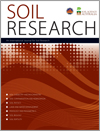Phosphorus leaching and runoff from agriculture require management to reduce algal blooms and fish kills in waterways. Soil tests used for agricultural purposes can assist farmers to determine fertiliser requirements as well as help to identify the risk of phosphorus loss. Widespread adoption of soil testing and evidence-based fertiliser management can significantly reduce the risk of phosphorus loss.
SR22167 Abstract | SR22167 Full Text | SR22167PDF (6.4 MB) Open Access Article





